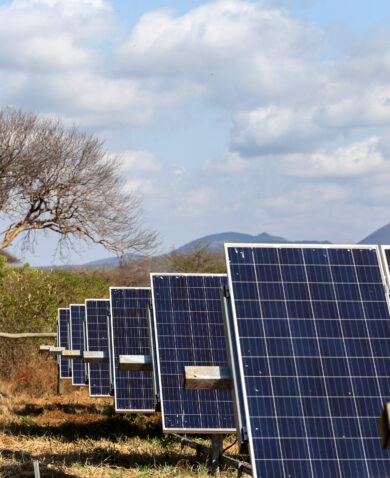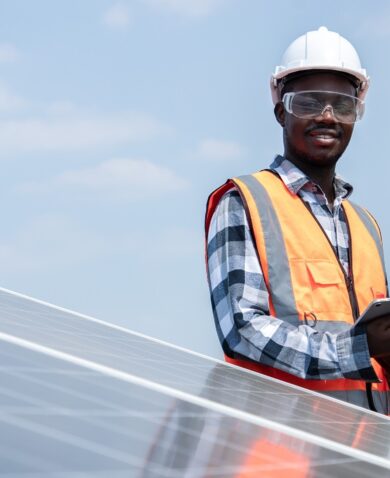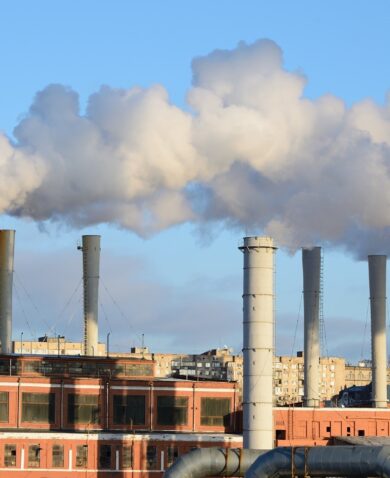
Reducing Fossil Fuel Use Is Key to the Sustainable Energy Transition
June 15, 2023 | 4 Minute ReadDevelopment agencies are promoting renewable energy development all over the world. Now can they help reduce the burning of fossil fuels?
The Intergovernmental Panel on Climate Change’s (IPCC) Sixth Assessment Synthesis Report (AR6), issued in March 2023 features a stark message: the decisions that we make right now will have profound implications for the future. In the energy sector, such decisions must focus on incentives for reducing fossil fuels and development agencies, such as USAID, are well positioned to assist countries in making that possible. Although there is now great momentum in renewable energy development around the world, more renewable energy output will turn the tide against climate change only if it leads to reduced burning of fossil fuels.
The contrast between our current pathway in fossil fuel use and the one that we need to follow is growing sharper. In the AR6, the IPCC reports there is a global emissions budget of 510 GtCO2 the world can emit across all sectors through 2050 in order to stay at the 1.5 degree Celsius threshold. Investments in fossil fuel-based energy, however, are already locked in to produce 850 GtCO2 by 2050. Over the last several years, fossil fuel consumption has remained largely stable at roughly 80-85% of the world’s total energy mix. This contrasts with the IPCC’s statement that staying at a 1.5 or even 2 degrees Celsius threshold “would involve rapid and deep and, in most cases, immediate greenhouse gas emissions reductions in all sectors this decade.”
Why has it been difficult to draw down fossil fuel usage? Amid the multitude of reasons, our “path dependence” on fossil fuel-based development impedes the shift to low-carbon alternatives even when they become more economically viable. This dependence manifests in long asset (e.g., coal power plant) lifetimes and regulatory and institutional ruts, such as long-standing patterns of subsidizing fossil fuels. This is why countries such as the Philippines, ranked as one of the top ten countries in addressing climate change by the Climate Change Performance Index, is still forging ahead with building new coal power plants despite its moratorium on coal plant development. This phenomenon has also placed countries like India in a paradoxical situation in which it’s increasingly difficult to transition away from fossil fuels when climate change-induced heatwaves drive enormous demands for power; the Indian government has already announced the plan for all coal power plants to run at full capacity this Spring.
Subsidies currently play an outsized role in keeping economies around the world bound to fossil fuels while also weakening energy security, resilience, and national budgets. For example, the 2022 energy supply challenges resulting from the Russia – Ukraine War compelled national governments around the world to significantly increase subsidies – more than doubling 2021 amounts – in order to manage price increases to electricity consumers. As the IEA notes, “spending to bring down energy bills represents a significant fiscal burden for governments and, as is often the case with such measures, these interventions have not always been well targeted. Furthermore, it risks diminishing the incentive to use energy efficiently or to switch to cleaner fuels.”
Abruptly shutting off fossil fuel subsidies without careful planning would be perilous to governments, however, as well as their constituents. As Neil McCulloch points out in Ending Fossil Fuel Subsidies: The Politics of Saving the Planet, subsidies are popular because the elite benefit from them, and hard to eliminate because the poor are likely to suffer when they’re removed. In fact, instances of political unrest associated with energy prices around the world have at times involved moves to reduce fossil fuel subsidies. Rutgers University’s Mark Paul and Lina Moe have also pointed out in An Economist’s Case for Restrictive Supply Side Policy: “Implicit in the strategy of focusing on clean energy investment is the assumption that fossil fuel firms will voluntarily close their doors as they get pushed out and exit the market in an orderly fashion. They will not. Without discrete restrictive supply-side planning and policy, the end of fossil fuels will be a chaotic collapse where workers, communities, and the environment suffer.” The removal of fossil fuel subsidies will thus require concerted political and economic planning in order to avoid destabilizing societies.
The Potential Role for USAID and Other Agencies
One of the most tangible ways that USAID could influence the displacement of fossil fuels is in working with host country governments to shift resources away from fossil fuel subsidies. This includes tapping deeper into the agency’s thought leadership in political economy and Thinking and Working Politically, as well as tailoring the public financial management support that USAID provides countries all over the world. These USAID-specific approaches could be used to help countries aggressively disentangle their economies from subsidies, such as modeling a program in which a country commits to phase out fossil fuel subsidies in exchange for a combination of grants and concessional financing to provide support to citizens through a targeted cash rebate program, incentives to switch to electric vehicles or adopt efficiency measures, and to spur clean infrastructure investment. Arguably, this type of approach is already happening at a broader scale through the diplomatic channels that flow through the UNFCCC, but a country-specific success story anchored by USAID assistance could provide an inspiring model for others to follow.
Additionally, reducing the incentives to consume more energy opens the way for more robust energy efficiency policies and could potentially close global investment gaps in renewable energy. This includes working with governments and businesses to promote building retrofits, efficient appliances, and efficient transportation. Furthermore, USAID could greatly expand its efforts to support putting prices on carbon emissions, such as through carbon taxes and cap and trade systems.
The urgent need to displace fossil fuels with renewable energy also aligns with USAID’s strategic focus on resilience. Eighty percent of the world’s population lives in countries that are net importers of energy, which means that most of the world is exposed to global market shocks, as 2022 demonstrated. Renewable energy technologies such as solar and wind are not fuel based, and are more modular in scale, and often less capital intensive. Critically, global events such as wars would have minimal disruptive impact on electricity supply produced domestically by renewables. In fact, Ukraine has been rapidly adopting solar PV in response to Russian attacks on their power grid. Replacing fossil fuels with renewable energy can thus provide developing countries with greater confidence and stability in electricity supply and pricing. Additionally, renewable energy provides vital lifelines to communities impacted by catastrophic weather events and disasters. Small island developing states, for example, are at once some of the most remote and vulnerable geographies while also some of the most dependent countries on imported fossil fuels. By replacing fossil fuels with renewable energy, they can reduce their vulnerability to price volatility and supply disruptions, which would be a key victory for USAID’s New Resilience Policy.
Posts on the blog represent the views of the authors and do not necessarily represent the views of Chemonics.












